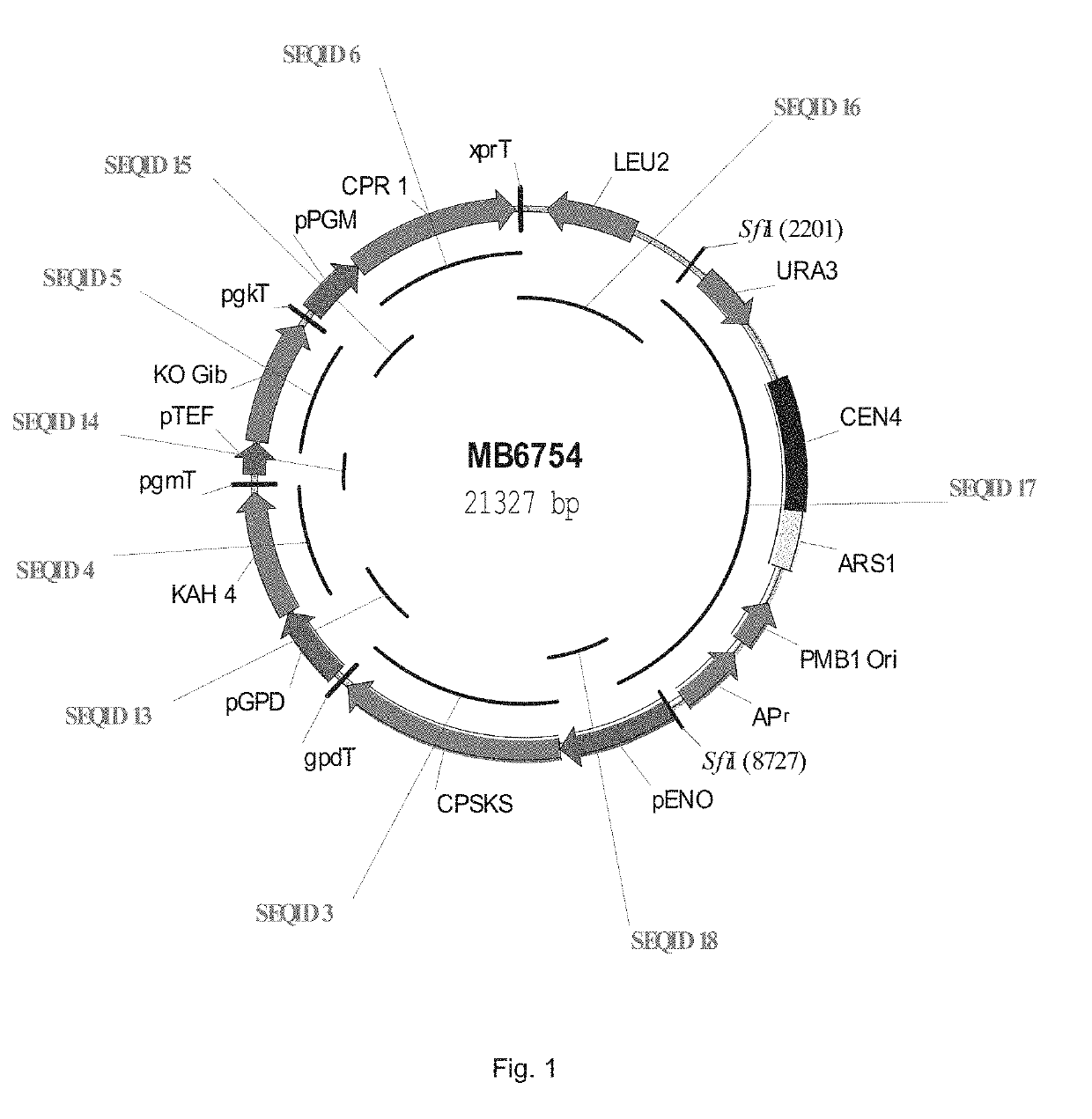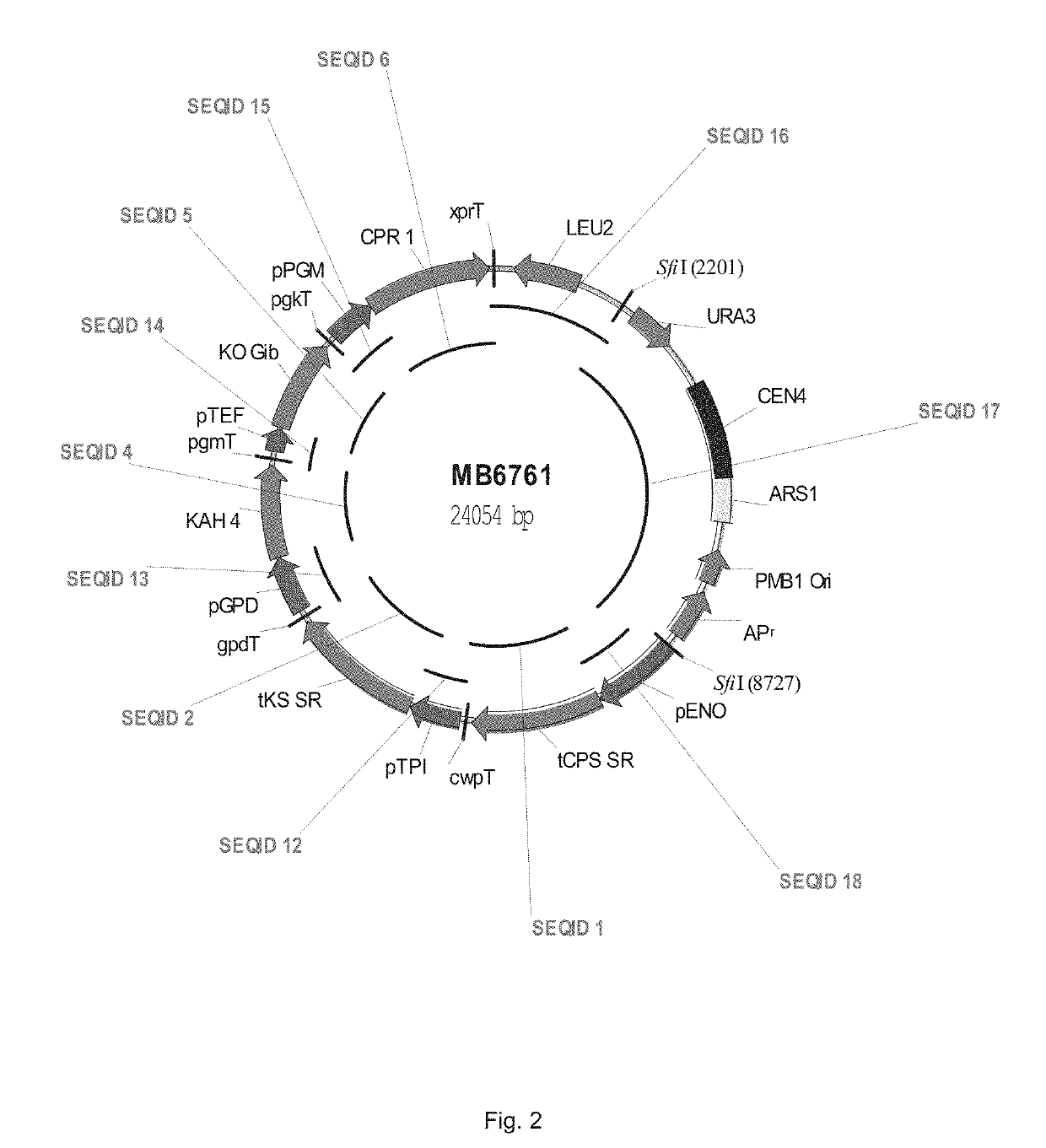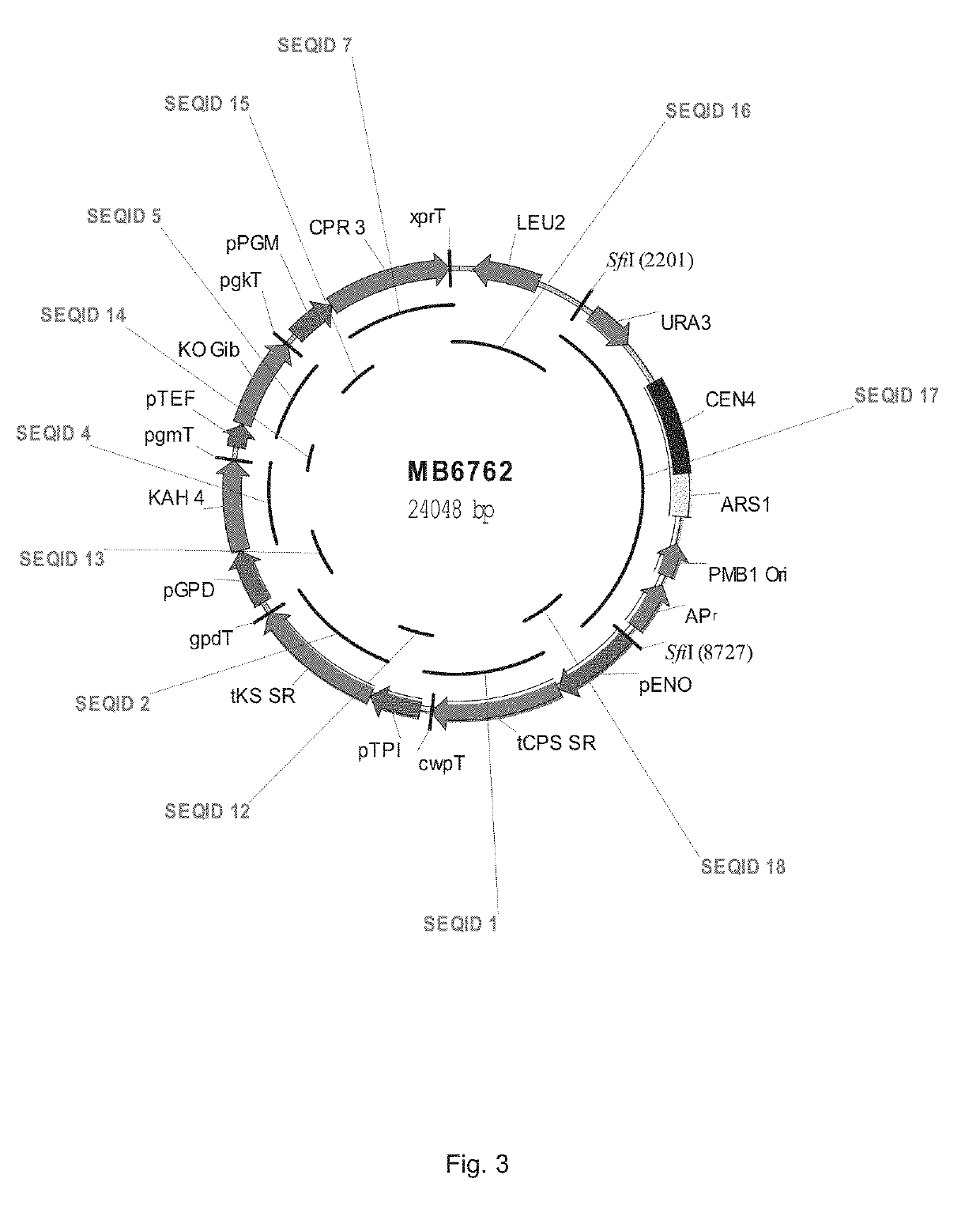Diterpene production in yarrowia
a technology of yarrowia and yarrow, which is applied in the direction of lysine, transferase, enzymology, etc., can solve the problems of large land area, long time, and variable yields
- Summary
- Abstract
- Description
- Claims
- Application Information
AI Technical Summary
Benefits of technology
Problems solved by technology
Method used
Image
Examples
example 1
ion of Steviol Producina Strains of Recombinant Yarrowia lipolytica
[0260]Plasmids pMB6754, pMB6761, and pMB6762 (see Table 1 and FIGS. 1, 2 and 3) encoding genes for the synthesis of steviol were constructed as follows. Open reading frames for tCPS (SEQ ID NO: 182), tKS (SEQ ID NO: 183), CPSKS (SEQ ID NO: 184), KOGib (SEQ ID NO: 186), KAH4 (SEQ ID NO: 185), CPR1 (SEQ ID NO: 187) and CPR3 (SEQ ID NO: 188) were codon pair optimized using codon pair optimisation technology as disclosed in PCT / EP2007 / 05594, for expression in Yarrowia lipolytica.
[0261]The optimized sequences, flanked by 60 bp of the desired promoter and terminator, were synthesized by GenScript (SEQ ID NOS: 182-188), and amplified by PCR using appropriate primers. DNA fragments encoding terminator-promoter sequences, TPI promoter, or Yarrowia lipolytica markers were amplified by PCR from existing constructs (SEQID 193-197 and 199). Vector DNA (SEQID 198), consisting of the S. cerevisiae centromere-based URA3 plasmid YC...
example 2
ion of RebA Producina Strains of Recombinant Yarrowia lipolytica
[0263]Plasmid pMB6775 (see Table 1 and FIG. 4) encoding genes for the synthesis of RebA was constructed as follows. Open reading frames for a UGT1, UGT3, UGT4, and UGT2 were codon pair optimized using codon pair optimisation technology as disclosed in PCT / EP2007 / 05594, for expression in Yarrowia lipolytica. The optimized sequences, flanked by 60 bp of the desired promoter and terminator, were synthesized by GenScript (SEQ ID NOs 189-192), and amplified by PCR using appropriate primers. DNA fragments encoding terminator-promoter sequences or Yarrowia lipolytica markers were amplified by PCR from existing constructs (SEQ ID NOS: 194-196,199 and 200). The vector (SEQ ID NO: 198), consisting of the S. cerevisiae centromere-based URA3 plasmid YCp50 (Rose et al., supra) with ENOp from Yarrowia replacing the tet gene using standard techniques, was prepared from E. coli and digested with XbaI and SnaBI. All fragments were puri...
example 3
n of RebA by Yarrowia
[0266]The Y. lipolytica strain ML13113 constructed as described above, was cultivated in shake-flasks (2 l with 200 ml medium) for 1 days at 30° C. and 200 rpm. The medium was based on Verduyn et al. (Verduyn C, Postma E, Scheffers W A, Van Dijken J P. Yeast, 1992 July; 8(7):501-517), with modifications in the carbon and nitrogen sources, as described in Tables 12 and 13.
TABLE 13Preculture medium composition Y. lipolytica strain ML13113ConcentrationRaw materialFormula(g / kg)Glucose.1aqC6H12O6•1H2O22.0Urea(NH2)2CO2.3Potassium dihydrogen phosphateKH2PO43.0Magnesium sulphateMgSO4•7H2O0.5Trace element solution1Vitamin solution1ConcentrationComponentFormula(g / kg)aTrace elements solutionEDTAC10H14N2Na2O8•2H2O15.00Zincsulphate•7H2OZnSO4•7H2O4.50Manganesechloride•2H2OMnCl2•2H2O0.84Cobalt (II) chloride•6H2OCoCl2•6H2O0.30Cupper (II) sulphate•5H2OCuSO4•5H2O0.30Sodium molybdenum•2H2ONa2MoO4•2H2O0.40Calciumchloride•2H2OCaCl2•2H2O4.50Ironsulphate•7H2OFeSO4•7H2O3.00Boric acidH...
PUM
| Property | Measurement | Unit |
|---|---|---|
| temperature | aaaaa | aaaaa |
| temperature | aaaaa | aaaaa |
| temperature | aaaaa | aaaaa |
Abstract
Description
Claims
Application Information
 Login to View More
Login to View More - R&D
- Intellectual Property
- Life Sciences
- Materials
- Tech Scout
- Unparalleled Data Quality
- Higher Quality Content
- 60% Fewer Hallucinations
Browse by: Latest US Patents, China's latest patents, Technical Efficacy Thesaurus, Application Domain, Technology Topic, Popular Technical Reports.
© 2025 PatSnap. All rights reserved.Legal|Privacy policy|Modern Slavery Act Transparency Statement|Sitemap|About US| Contact US: help@patsnap.com



